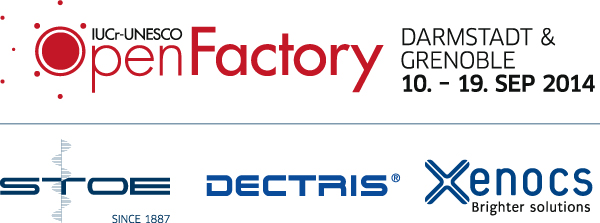The United Nations have proclaimed 2014 as ‘the International year of crystallography’. Xenocs is very proud to support UNESCO & the International Union of Crystallography (IUCr), through the organization together with its partners STOE & DECTRIS of a so called OpenFactory that will give young scientists from all over the world the opportunity to receive high quality education free of charge.
High Quality Education and Unique Networking Opportunity
Participants will receive 7 days of intensive training, from September 10 to 19, by STOE, DECTRIS and Xenocs staff and guest scientists in cooperation with the IUCr. The first three days will be held in Grenoble, France, where Xenocs is located. Selected candidates will receive high quality training, both theoretical and practical, on Small & Wide Angle X-Ray Scattering. They will also spend significant time at ESRF (European Synchrotron) where they will have the opportunity to visit the main beamlines and interact with scientists.
The last four days will take place in Darmstadt where participants will be trained in Single Crystal and Powder XRD at STOE’s headquarters. They will also have the opportunity to join Stoe’s annual user meeting starting on September 18. This meeting will be a unique opportunity for the OpenFactory participants to interact with highly experienced XRD users and to build up relevant networks.
Free of charge
As mentioned above, the event is free of charge for the delegates, as Xenocs, STOE and DECTRIS will cover round-trip flights from the delegates’ home country, hotel, food and transport costs.
For 21 young scientists across the world
Any young scientist with some background on crystallography can apply. These scientists shall have a profile (academic track record, CV) that indicates that they have the potential to become future thought-leaders for crystallography and application of XRD and X-Ray scattering in their home country. Selection will be made jointly by IUCr and the three companies involved. Xenocs will sponsor one candidate from each continent/subcontinent (Asia, India, Australia/Oceania, Africa, South America, North America, Europe), 7 in total. Stoe will sponsor mainly Eastern Europe delegates even though they are also opened to others, whereas Dectris will put their focus on Africa.
IUCr President Prof. Gautam R. Desiraju’s support
This initiative has been largely supported by IUCr President Prof. Gautam R. Desiraju who warmly welcomed the initiative at the Opening Ceremony of the International Year of Crystallography that took place at UNESCO in Paris on January 20-21. “We believe this is a unique opportunity for young scientists to be trained and to build up their network in the crystallographer community”, Prof. Gautam R. Desiraju said.
Application Process
Candidates are encouraged to submit their written application, including CV and an essay before March 30 2014.
For more information and application process, please visit www.iycr2014.org/openfactory.
Highlight on ‘2014 International Year of Crystallography’
2014 marks the centenary of the birth of X-ray crystallography. In 1912, Max von Laue discovered that crystals could diffract X-rays and won the Nobel Prize in Physics for this discovery two years later. In the same year, William Henry Bragg and William Lawrence Bragg (father and son) were the first to use x-rays to determine the organization of atoms within crystals. W.L.Bragg established the so called ‘Bragg law’ that enables to determine the interatomic distances in a crystal thanks to X-Ray diffraction. These discoveries have revolutionized our understanding of matter and were the start of “100 years of groundbreaking discoveries” in crystallography, as Secretary-general of the United Nations Ban Ki-Moon said in a video webcast of IYCr’s opening ceremonies in Paris on January 20–21.
According to IUCr, a total of 29 Nobel Prizes have been awarded for work related to crystallography. These range from the discovery of X-rays by Wilhelm Röntgen at the turn of the last century to more recent awards for quasicrystals and structures of the ribosome and G protein-coupled receptors.





































